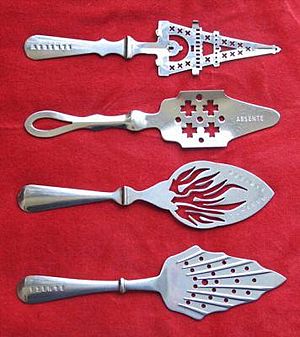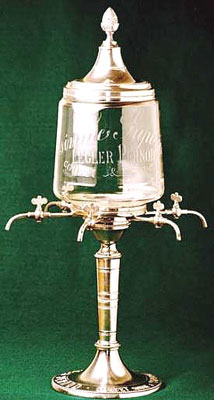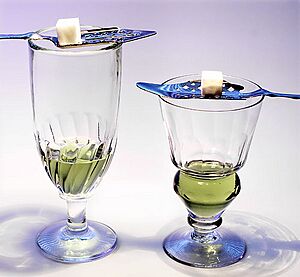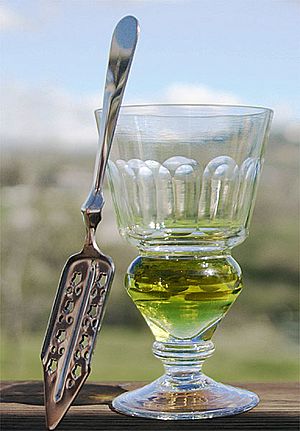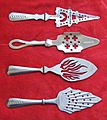Absinthiana facts for kids
Absinthiana are special tools and accessories used with a drink called absinthe. These items help prepare and serve the drink. At first, people used simple wine glasses and water pitchers. But as absinthe became more popular, many unique items appeared. These included fancy glasses, special spoons, and complex water drippers.
Many old companies from the 1800s used these special tools to advertise their brands. Today, some companies still make decorative items for the same reason. These old tools are now valuable collector's items.
Contents
Absinthe Spoons
An absinthe spoon is a special spoon with holes in it. People use it to hold a sugar cube over a glass of absinthe. Water is then poured over the sugar, making it dissolve into the drink. This helps sweeten the drink and make it less bitter.
These spoons are usually flat. They have a small notch on the handle. This notch helps the spoon rest on the edge of the glass. Absinthe spoons first appeared around the 1870s. They became very popular in the 1880s and 1890s.
Many spoons had brand names or logos stamped on them. This was a way for companies to advertise. Some spoons were even sold as souvenirs. For example, some were shaped like the Eiffel Tower. One famous spoon, Eiffel Tower #7, was made for the building's opening in 1889.
A less common type of absinthe spoon looks like a long iced tea spoon. These spoons have a normal bowl. But the part that holds the sugar is built into the handle.
Grilles
Another tool for sugar is called a grille. It doesn't look like a spoon. A grille is usually a metal plate with holes. It has three or more small legs. These legs hold the grille above the glass.
Water Drippers
Absinthe is usually mixed with ice-cold water. This is because absinthe is often bottled as a very strong drink. Adding water makes it weaker, similar to the strength of wine. When water is added, the drink also becomes cloudy. This cloudy effect is called the louche.
Some people thought adding water to absinthe was an art. It needed patience and skill. In some bars, people called "Les professeurs d'absinthe" (absinthe teachers) would show new drinkers how to do it. They would teach how to add water slowly. This helped bring out the best flavor and smell of the drink.
Carafe
A water carafe is the simplest way to add water. It's like a small pitcher. Many old carafes have brand names on them. You hold the carafe above the glass. Then, you carefully pour a thin stream of water into the absinthe.
Fountain
Absinthe fountains became popular in bars in the late 1800s. A fountain is usually a large glass globe on a tall metal stand. It can have two to six spigots, or small taps. This allowed several people to prepare their absinthe at once. It provided a slow, thin stream of cold water. This was easier than using a carafe, which needed a very steady hand.
Brouilleur
Sometimes, a device called a brouilleur was used. A brouilleur is a small glass or metal bowl. It sits on top of the absinthe glass. It works like a personal absinthe fountain. You put ice and water into the bowl. The bowl has a small hole at the bottom. This lets the cold water slowly drip into the absinthe. If you wanted sugar, you could add it directly to the bowl. Some brouilleurs even had a built-in grille for sugar.
Absinthe Glasses
Absinthe was first served in regular drinking glasses. But over time, special glasses became popular. These glasses often had a short, thick stem. They might have special designs or marks to show how much absinthe to pour. Some simply had a line or a glass bead. This showed the correct amount of absinthe. Another line or bead showed how much water to add.
A "reservoir glass" is a type of absinthe glass. It has a distinct bulge at the bottom. This bulge holds the right amount of absinthe for one serving. The rest of the glass is filled with water. This gives the correct mix. These were some of the first glasses made just for absinthe.
A less common type is the "bubble-reservoir glass." It has a bubble-shaped reservoir. This bubble is connected to the main glass by a narrow opening. This design allows the absinthe and water to mix slowly. It makes the cloudy "louche" effect look even better.
Modern Absinthiana
Absinthe became popular again in the 1990s. This happened after new laws in Europe made it easier to make and sell. As absinthe returned, so did its special tools. Several companies now make copies of old absinthiana. Some have also updated the traditional designs. In the 1800s, absinthe barware was often cheap advertising. Today, modern versions are sometimes made from silver or are very fancy, like jewelry.
See Also
Images for kids
-
Left, Swirl glass.
Right, Pontarlier reservoir glass.


